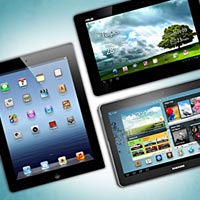 After watching its Android operating system struggle in a tablet market dominated by the iPad, Google may be ready to introduce its own hardware into the fray. According to
tech blog The Verge, a device co-branded with hardware maker Asustek could reach consumers as early as July.
The 7-inch tablet is expected to run the forthcoming tablet-optimized version of Android, version 4.0 or “Ice cream sandwich.”
After watching its Android operating system struggle in a tablet market dominated by the iPad, Google may be ready to introduce its own hardware into the fray. According to
tech blog The Verge, a device co-branded with hardware maker Asustek could reach consumers as early as July.
The 7-inch tablet is expected to run the forthcoming tablet-optimized version of Android, version 4.0 or “Ice cream sandwich.”
The report claims that Google is trying to pack a lot
of horsepower into a bargain-priced frame in order to distinguish itself. The hardware specs include a Nvidia Tegra 3 quad-core CPU to deliver better performance than the dual-core processors driving
lower-end tablets.
Verge reports that Google is trying to price its hardware at least on par with the most successful Android-based tablet to date, Amazon’s Kindle Fire. The Fire runs a
“forked” version of the Google OS that keeps users within Amazon’s own walled garden of approved apps and billing system. The move underscores the growing competition between Google
and Amazon for the second tier of the tablet market. Google’s recently revamped Android Marketplace, Google Play, now includes the eBooks, movie rentals and TV programming that mimics
Amazon’s multimedia e-store.
Google wants to open up a viable Android tablet market in its larger competition with Apple in the space. So far, Google has not been able to leverage
its open platform OS in tablets in the same way it has so successfully in smartphones. While tablets from Motorola, Asus, Samsung and others have come into the market at small and large screen sizes,
none has gotten serious traction with consumers until Amazon introduced its low-priced but more closed Kindle Fire.
Amazon succeeded with the Fire largely because it could fill the device
catalogs with troves of multimedia content and not rely on the scant number of tablet-specific apps in the Android market. In developing its Play market, Google appears to be following Amazon’s
lead in giving all devices -- but especially tablets -- a range of content for buyers to consume.
But Google has not had much success selling devices directly to consumers, even if its brand
helps raise the profile of hardware sold by partner OEMs. Its past attempts to jumpstart the Android smartphone market with the original Google G1 phone and the more recent NFC-enabled Nexus have been
relatively ineffectual as direct-to-consumer plays. On the other hand, bringing the Google name to the wide range of Android hardware from so many vendors in the market could help give the fragmented
market greater clarity.
Market researchers ABI and IDC both have predicted that in the coming years, low-priced, Android-powered tablets will erode Apple’s share of the tablet
terrain. ABI has predicted that the worldwide appeal of sub-$400 tablets will give the Android OS 60% of the market by 2016.
Apple appears to be increasingly aware of the low end of the
market. With the introduction of the newest version of the 9.7-inch iPad starting at $499, Apple elected to keep its previous generation of iPad 2s in market at a lower $399 price point. Rumors
persist that the company is also testing a smaller version of the iPad that is at the larger end of the 7-inch scale. Steve Jobs famously chided the early Android 7-inch devices as being too small for
efficient and enjoyable touch interactions with tablet-scale experiences.